Change Page: 12 > | Showing page 1 of 2, messages 1 to 20 of 25 - powered by ASPPlayground.NET Forum Trial Version
Author
|
Message

|
 Breeding Journal, Species: Mithraculus forceps
Monday, September 2, 2013 9:09 AM
Breeding Journal, Species: Mithraculus forceps
Monday, September 2, 2013 9:09 AM
( permalink)
Breeding Journal DataSheet
This first post should be updated regularly to include new information as events take place or changes are made to your system General Species: Mithraculus forceps Social Structure: Multiple individuals in the tank Size of Individuals: Two smaller (about 3/4 inch carapace length) and two larger (1+ inch carapace length) Age of Individuals: Unknown, wild caught Date added to Tank: Early August, 2013 Broodstock Tank Details Size of Tank: 30 gallon Substrate Details: Sand Filtration Details: Live rock, canister filter Water Changes: 5 gallons once a week or once every two weeks Water Temperature: ~78-80 Lighting: LED fixture Lighting Cycle: 6AM to 8PM Other Tank Inhabitants: Clibanarius tricolor (multiple), one scarlet hermit, Spotted mandarin, A. ocellaris pair, Columbellid snails Broodstock Feeding Details Food Types: Flake, blackworms, frozen mash, and plenty of algae growing in the tank Feeding Schedule: At least twice a day, can graze constantly Spawning Details Date of First Spawn: Unknown Spawn Time of Day: Unknown Dates of Consecutive Spawns: 8/29/2013 (this is an ESTIMATED spawn date. Spawns are hidden in the egg pouch area and are rarely seen unless you catch the crab aerating the eggs or the spawn is huge. I estimated the spawn date to be ~2 weeks prior to the hatch date, but I have no real information to base this on.) Courtship Details: None noted Egg Size: Unknown Egg Color: Unknown Egg Count: Unknown Hatch Details Hatch Date: 8-30-2013, 9-11-2013, 9-12-2013, 9-23-2013 (small) Hatch Time of Day: After lights out # Days after Spawn: Unknown Larvae Description: Look like small balls to the naked eye that are ~0.5mm round, when they stretch out they look like a ball (the head) with a skinny tail sticking out. Under the microscope they look like creepy aliens ready to take over the planet. Larval Tank Details Temperature: Room temperature, ~75-80F Size of Larval Tank: 3L inverted plastic water bottle, then moved to a circular one gallon tupperware container that had a flat base Substrate Details: None Other Tank Decor: Rigid airline Filtration Details: None other than live phyto Lighting: Fluorescent strip light Lighting Cycle: 6AM to 9PM Water Changes: As needed to flush out prey that has become too large Larval Feeding Details Food Types: nhbbs and live phyto Feeding Schedule: Constant Metamorphosis/Settlement Date of Settlement Start: 9-21-2013 (estimated based on when I stopped seeing megalopae in the water column) Days after Hatch: Started around Day 9, by Day 11 all but one had molted to crab. There was one transitional megalopa on 9-23-2013 (I call it that because it has stopped cruising around in the water column, but instead associates with the bottom even though it is still a megalopa) Date of Settlement End: 9-24-2013 Description of Fry: Tiny crabs that measure just over 1mm carapace lenght/width. Lots of debris seem to stick to them
Grow-Out Tank Details Temperature: ~75-78F Size of Grow-Out Tank: 10 gallon Substrate Details: None Other Tank Decor: Sponge filters, yarn mops, macroalgae, zip-tie hitching posts Filtration Details: Sponge filters (two) Lighting: Fluorescent strip light Lighting Cycle: 6AM to 9PM Water Changes: As needed Size at Transfer: ~1.5mm carapace width, some smaller, some larger Age at Transfer: ~1.5 months; they were kept in a dishpan "growout" prior to being moved. Grow-Out Feeding Details Food Types: Algae in the tank, frozen spirulina enriched brine, ova, and live enriched bbs are fed to the other fish in the tank. The crabs get what is left over. Feeding Schedule: At least twice a day Additional Information (No Pictures or Videos in the Section Please) Miscellaneous Information: You will be required to provide photographic evidence in this thread of each event submitted for the MBI Program.
If your thread does not contain these photos the MBI Committee will not be able to approve your reports.
<message edited by shannpeach on Monday, December 30, 2013 9:45 AM>
|
|
|
 Re: Breeding Journal, Species: Mithraculus forceps
Monday, September 2, 2013 9:17 AM
Re: Breeding Journal, Species: Mithraculus forceps
Monday, September 2, 2013 9:17 AM
( permalink)
Here are some pictures of the adults before they were added. My LFS has a discount for four, so that's why I went with that many. The sizes were just dumb luck since the only "red" emerald crabs left for purchase were the four I got. 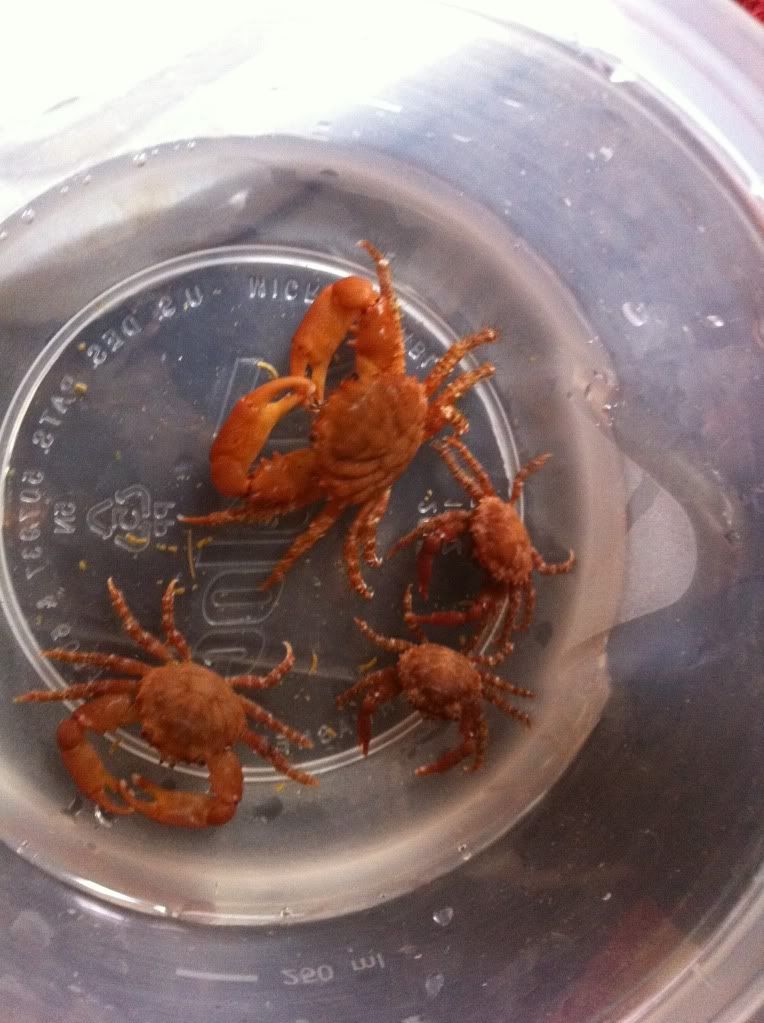 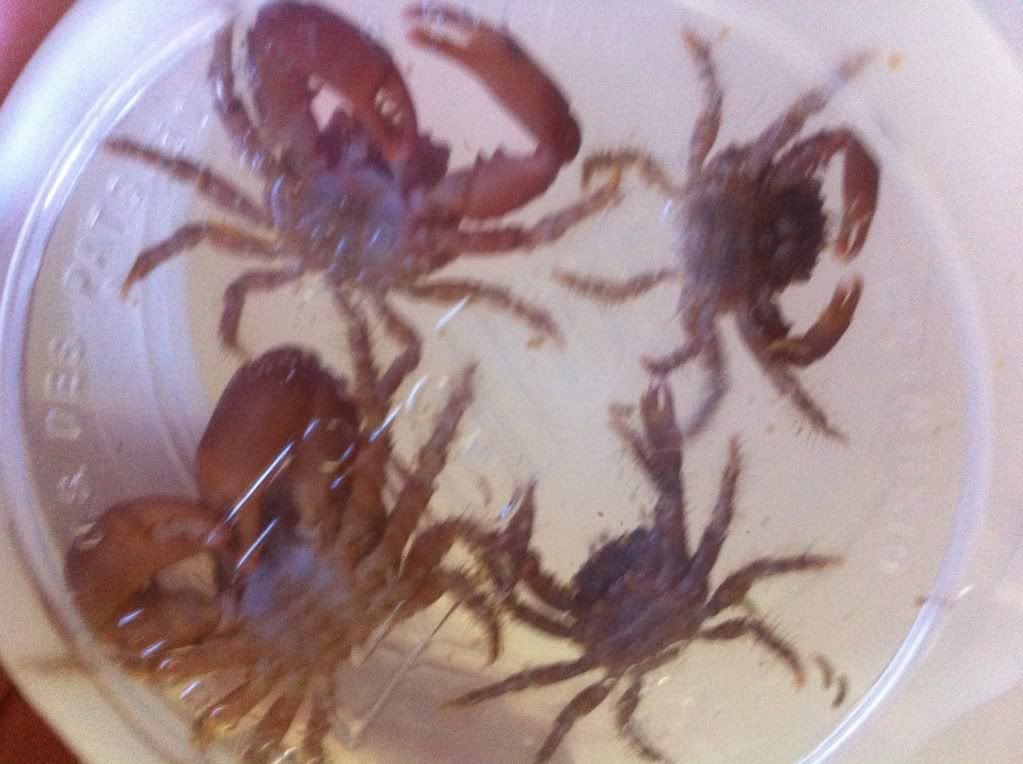 A couple in the tank  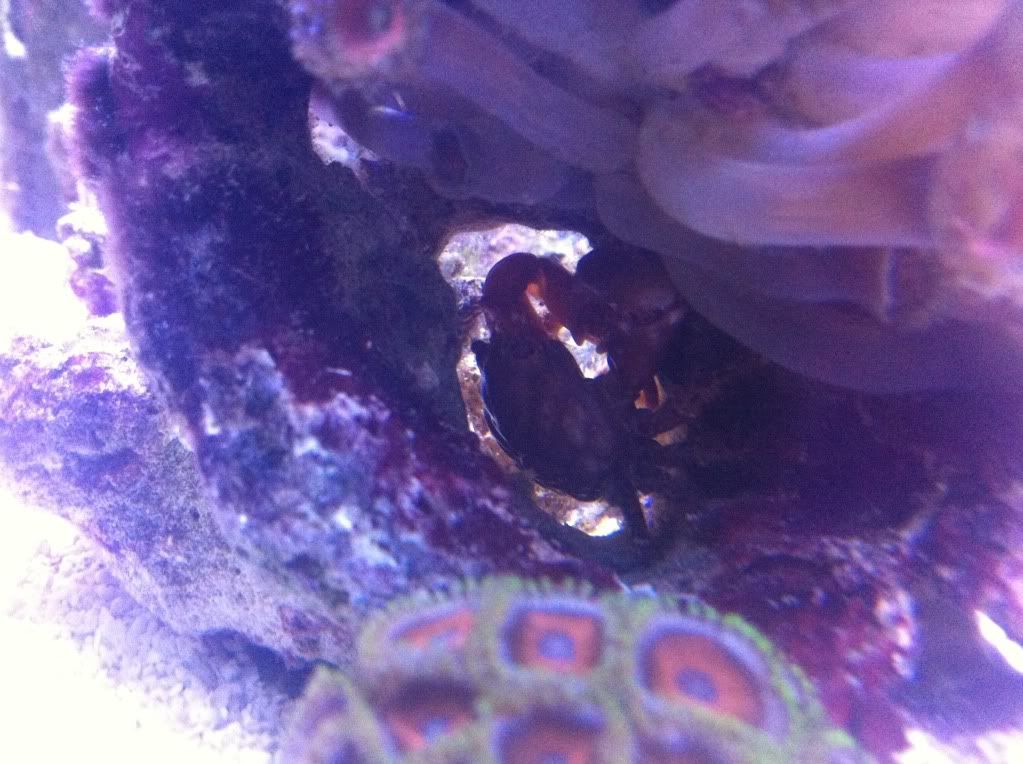 What they looked like after pulled out of the snagger (little white balls): 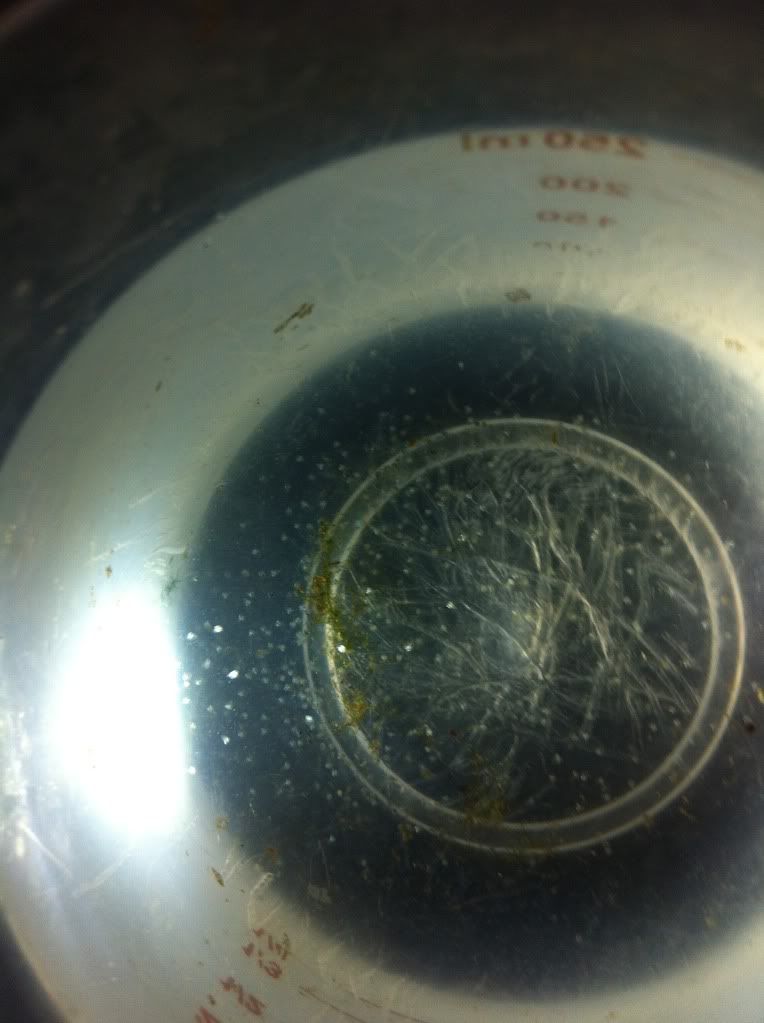 Video of them cruising around: 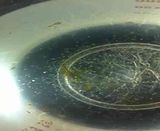 Then, day 1 under the microscope: 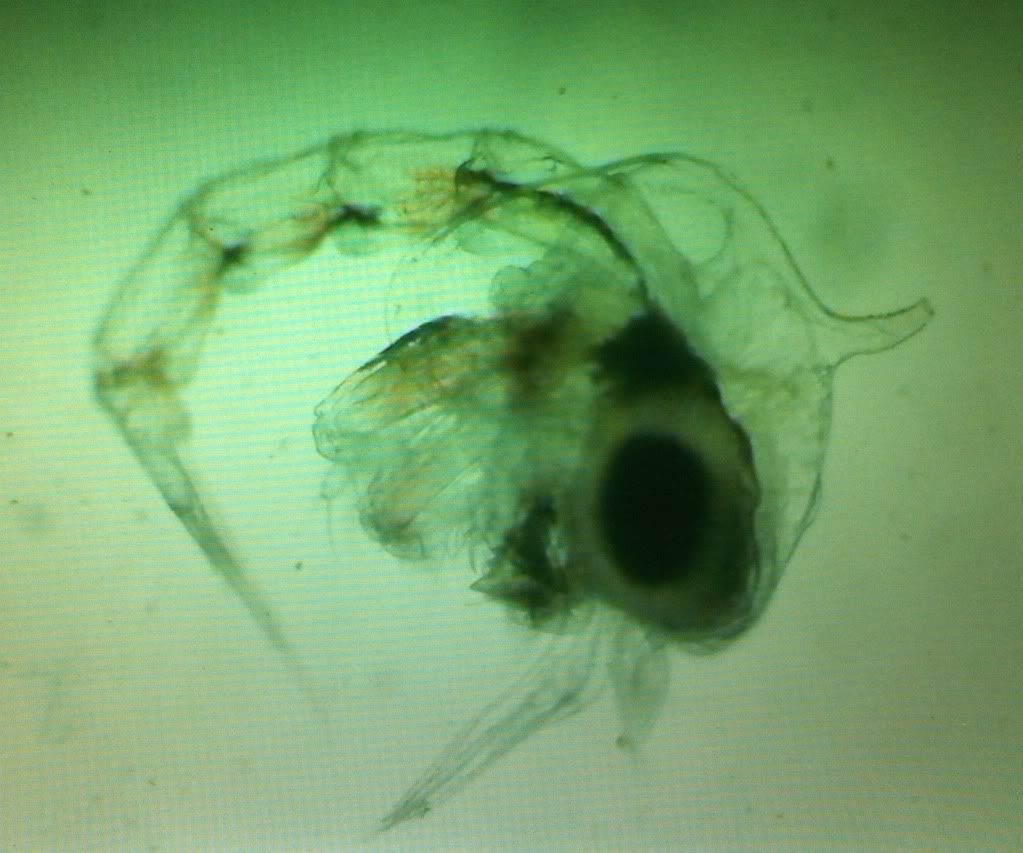 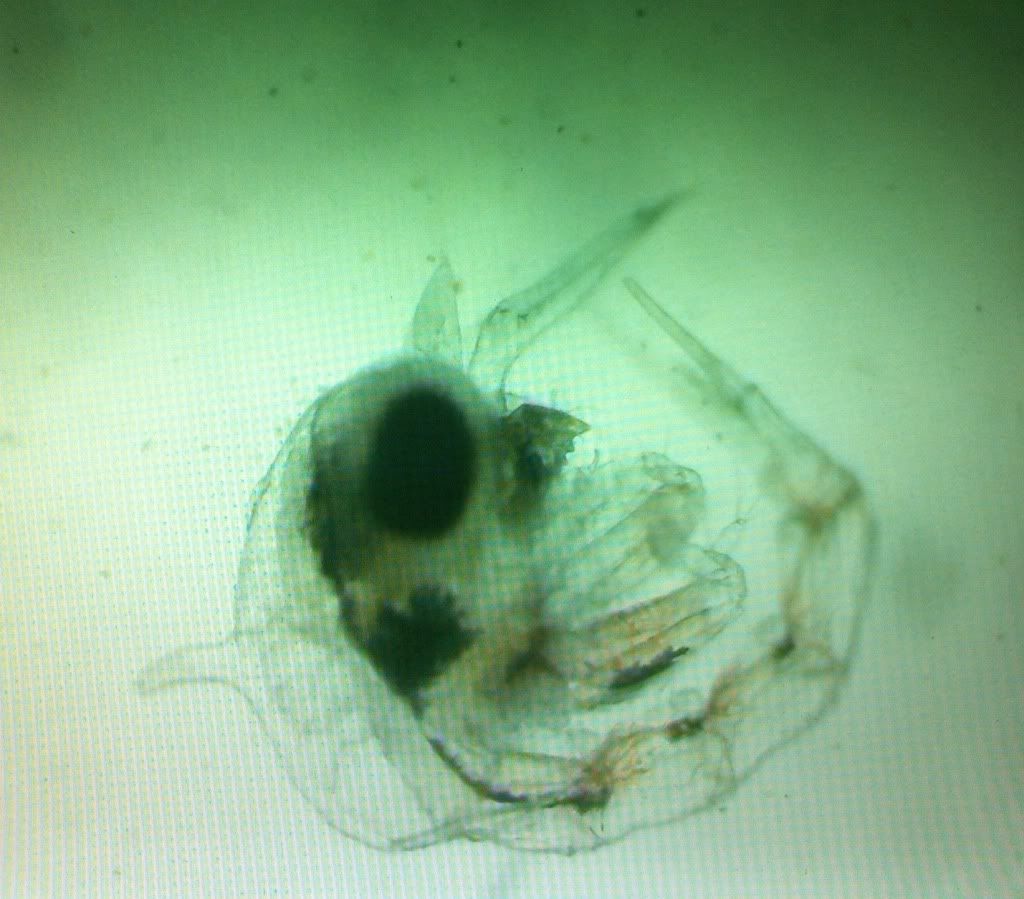 Over a ruler (the space between the black lines is 1mm): 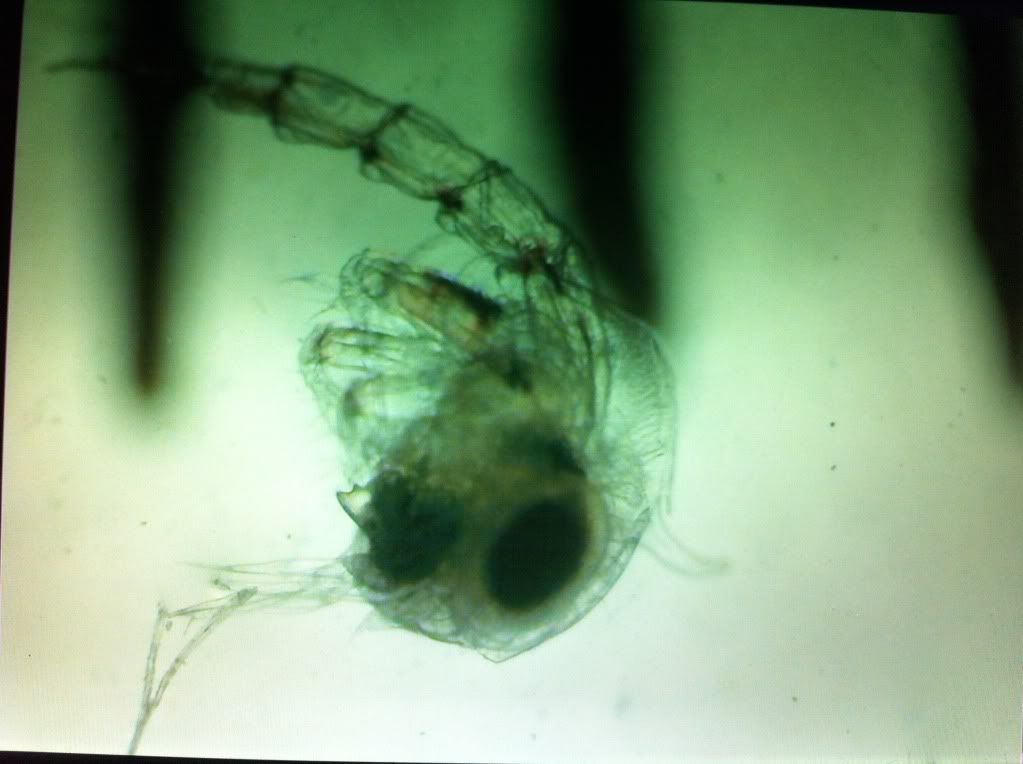 It looks like the carapace is just over half of a millimeter Stretched out, it measures just over 2mm: 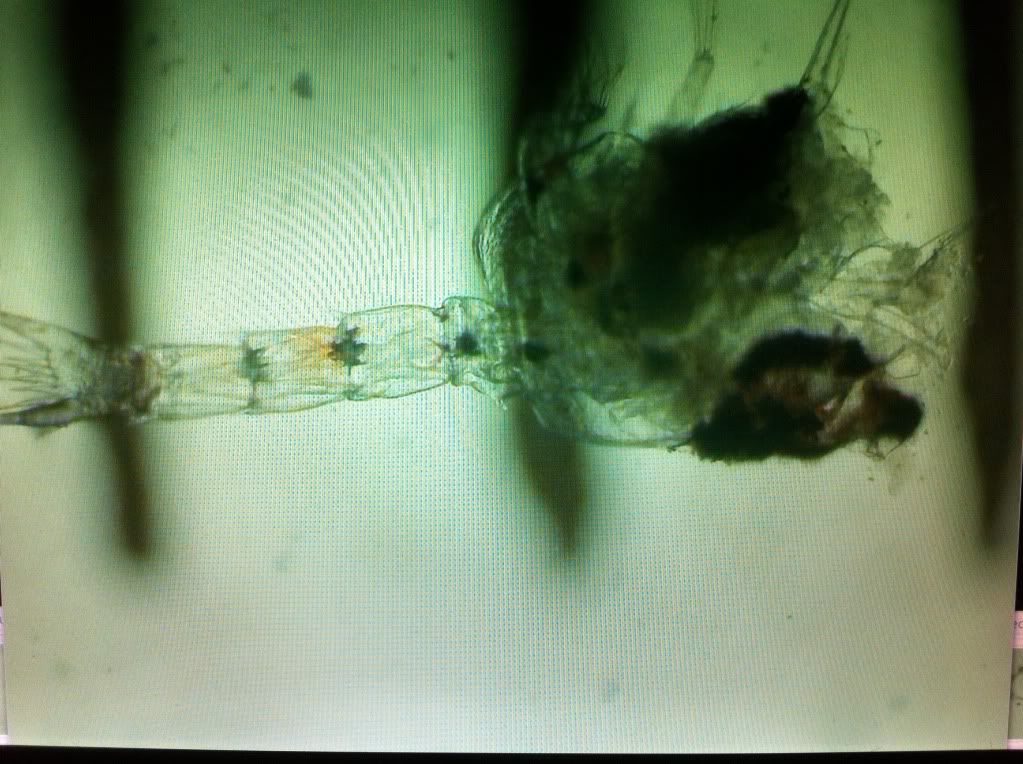 I also have some day 2 pics, but I didn't upload them yet so I can add them later. Both day 1 and day 2 should be the same larval phase (zoea 1) and then zoea 2 begins around day 3 to 4. Therefore, the day 2 pics likely won't look much different. I will also try to pull some today for pics if I get a chance later.
|
|
|
 Re: Breeding Journal, Species: Mithraculus forceps
Monday, September 2, 2013 5:32 PM
Re: Breeding Journal, Species: Mithraculus forceps
Monday, September 2, 2013 5:32 PM
( permalink)
|
|
|
 Re: Breeding Journal, Species: Mithraculus forceps
Wednesday, September 4, 2013 4:11 PM
Re: Breeding Journal, Species: Mithraculus forceps
Wednesday, September 4, 2013 4:11 PM
( permalink)
|
|
|
 Re: Breeding Journal, Species: Mithraculus forceps
Monday, September 9, 2013 12:21 PM
Re: Breeding Journal, Species: Mithraculus forceps
Monday, September 9, 2013 12:21 PM
( permalink)
These made it to Day 6 and zoea II before the last one disappeared. Next time I collect some I plan to put them in a different setup/container that will hopefully allow me to flush out the older prey items without having to manually baster each larvae, clean out the bowl, and then add them back in. That is not the ideal way to do it due to the additional transfer stress and also due to the amount of time it takes to get it done.
|
|
|
 Re: Breeding Journal, Species: Mithraculus forceps
Friday, September 13, 2013 8:32 AM
Re: Breeding Journal, Species: Mithraculus forceps
Friday, September 13, 2013 8:32 AM
( permalink)
I had a small hatch the night of Sept 11, and a larger hatch last night, Sept 12. The first hatch was collected with some L. boggessi larvae and are now with those in the fish bowl orb for the time being. The hatch I collected this morning went into a modified 3L water bottle: 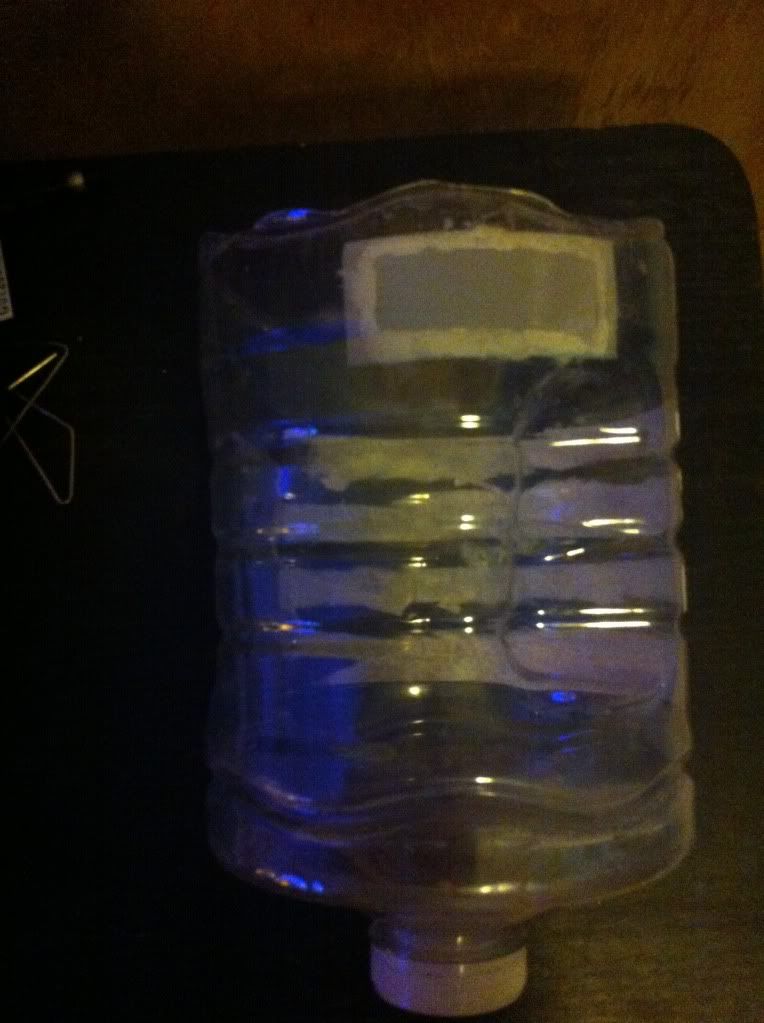 Essentially the bottom was cut off of the bottle and I cut out a small section and glued a piece of 400uM mesh on. Then I inverted the bottle and have it resting inside a water pitcher for now (eventually it will go into a different setup, but that's not ready right now. 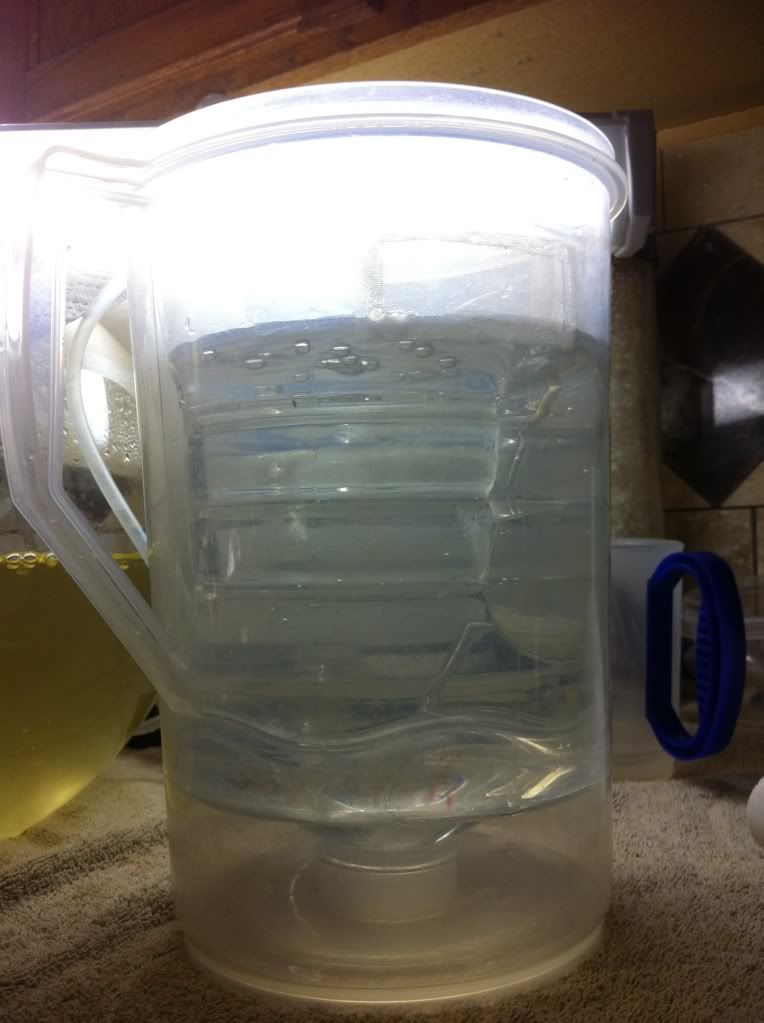 If I need to flush out old prey items, I can move the bottle to a larger bucket or whatever and then slowly drip in a couple gallons of water to flush the food out of the mesh. In theory. We shall see how it actually works when the time comes. I have rigid airline going to the bottom and bubbling slowly. I added nhbbs and a small amount of chaetoceros phyto.
<message edited by shannpeach on Thursday, September 19, 2013 1:06 PM>
|
|
|
 Re: Breeding Journal, Species: Mithraculus forceps
Monday, September 16, 2013 10:56 PM
Re: Breeding Journal, Species: Mithraculus forceps
Monday, September 16, 2013 10:56 PM
( permalink)
Today in addition to the nhbbs, they also got some 100-200uM golden pearls. This evening I did a 90% water change so I could move them to a new bottle (the new one has more of a cone shape to it). I added some nannochloropsis to tint the water. I pulled three to look at under the scope and they are still in zoea II which is not too surprising for day 4. There are 5 day old ones in with the peppermint shrimp larvae, but I did not look at those under the scope today. Those got a water change yesterday, 75% or so IIRC.
Last night I forgot to turn the light off. Today I was reading that they molt shortly after dark, which makes sense, but now I wonder if I delayed molting by leaving it on. Oh well! I will have to make sure to turn off the light from now on.
|
|
|
 Re: Breeding Journal, Species: Mithraculus forceps
Tuesday, September 17, 2013 11:01 PM
Re: Breeding Journal, Species: Mithraculus forceps
Tuesday, September 17, 2013 11:01 PM
( permalink)
I had some larvae that were caught with my peppermint shrimp larvae. I did a water change today on that fish bowl but did not see a single M. forceps larva. It is day 6 for that container, so I think I lose them when they tried to molt from zoea II to megalopa on the night of the fifth day. I have another container that is a day behind with zoea II larvae and tomorrow I will likely know if they make it or not. I have been consistently losing them at day 5-6. I hope in future runs to have the invert system done and have the water actually heated (right now it's at room temperature, which is 77F)
|
|
|
 Re: Breeding Journal, Species: Mithraculus forceps
Wednesday, September 18, 2013 7:54 PM
Re: Breeding Journal, Species: Mithraculus forceps
Wednesday, September 18, 2013 7:54 PM
( permalink)
This morning, day 6, and I saw that there were still some alive. I wasn't sure if they just hadn't molted or if they had molted to megalopa and actually survived. This afternoon I stopped at home for lunch and I couldn't help but take a peek. Megalopa! At least for a couple  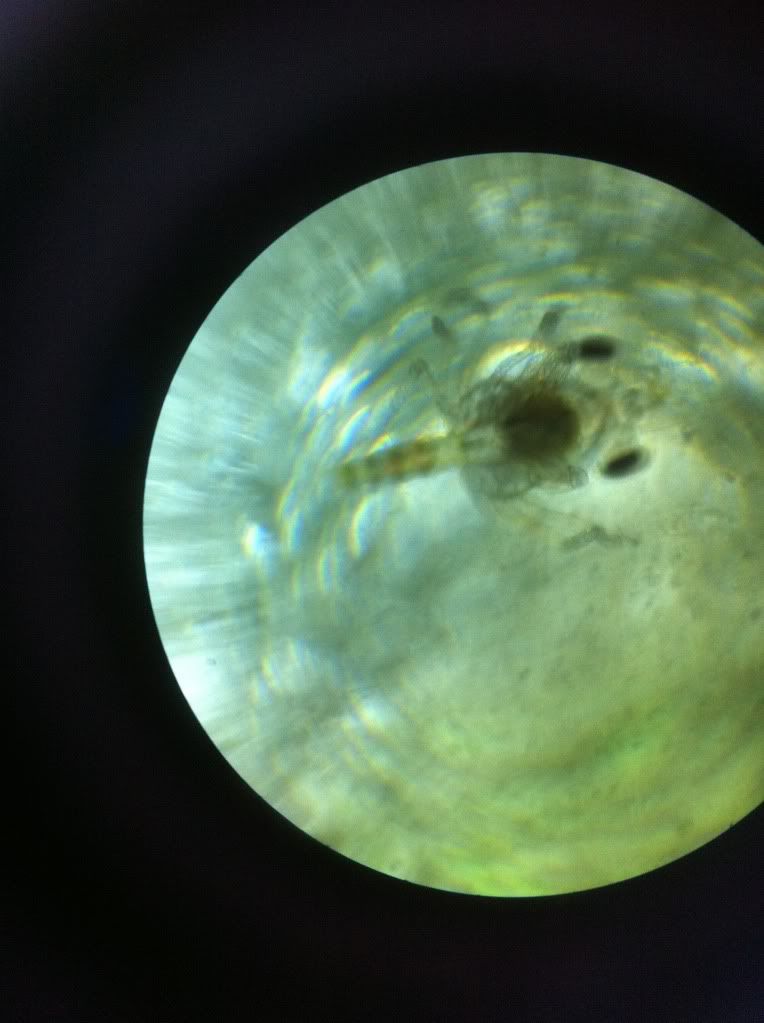 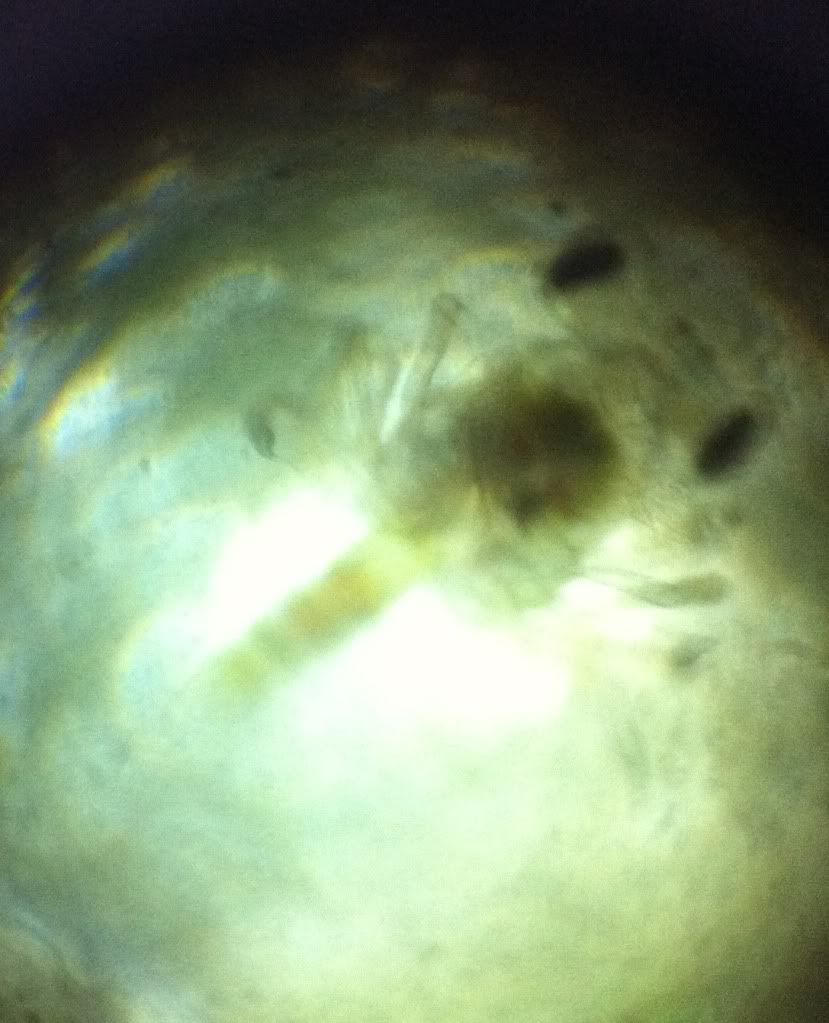 Sorry, I know the images are terrible. My laptop won't recognize my scope camera and the led light burned out on the scope so it's rigged with a light way too strong so I had to use a napkin to filter the light and then try to take a picture through the eyepiece with my iPhone. The end result isn't pretty but you can tell (I hope) that its a megalopa! Tomorrow I hope to use my other laptop (it's not at home currently) and could get better pics if they are still alive.
|
|
|
 Re: Breeding Journal, Species: Mithraculus forceps
Friday, September 20, 2013 10:12 AM
Re: Breeding Journal, Species: Mithraculus forceps
Friday, September 20, 2013 10:12 AM
( permalink)
Last night I did a nearly 100% water change (slow drip) because I moved them from the tall cone/pitcher set up to more of a bowl type setup. I counted about 15-20 that seemed to be alive. Some were much more active than others, and a couple were still in Zoea II (at least from what I guessed just by looking at them). First an iphone pic and video of them in the new container: 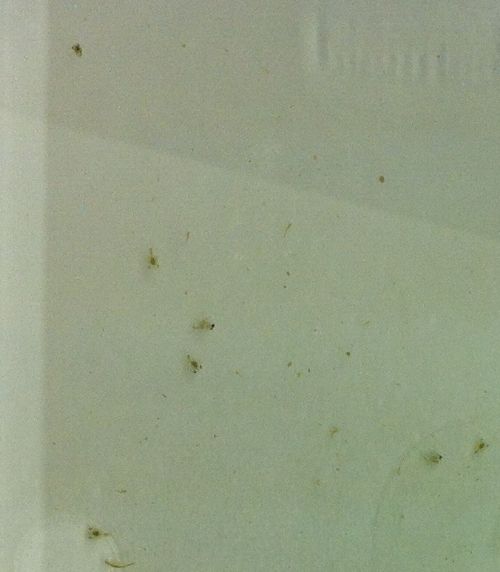 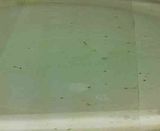 Then some better pics of the megalopas! 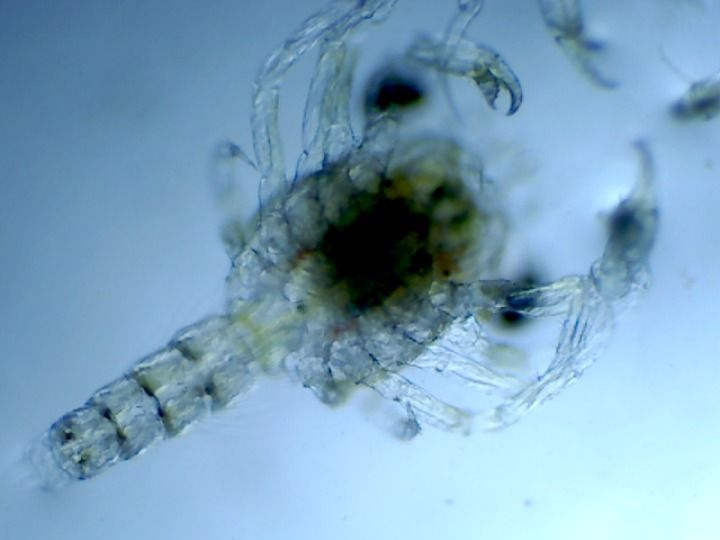 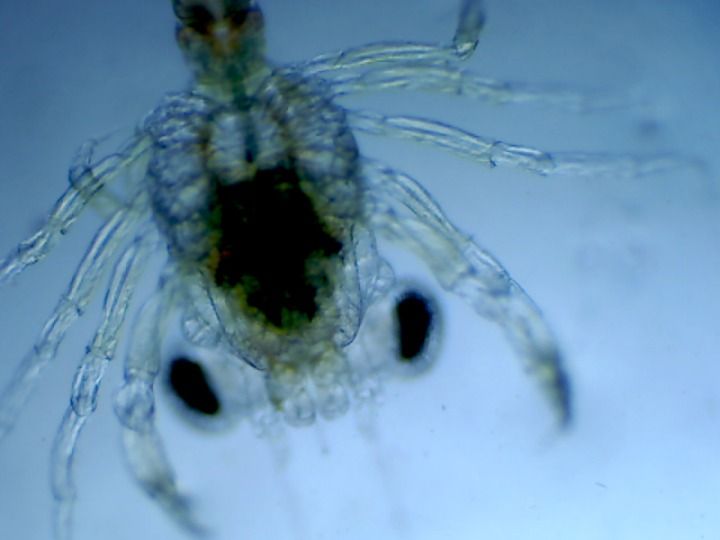  I read an interesting paper about some starvation trials and thought I would post a snippet of info from it regarding these guys. The paper is "Effect of starvation during late megalopa stage of Mithraculus forceps (Brachyura: Majidae) on larval duration, synchronism of metamorphosis, survival to juvenile, and newly metomorphosed juvenile size" by Figueiredo, Penha-Lopes, Narciso, and Lin published in Aquaculture: "In this study, M. forceps larvae subjected to starvation after 7 and 8 DPH (starting two and one day prior to metamorphosis to crab begins, respectively)displayed similar survival to juvenile, metamorphosis synchronism and larval duration to those continuously fed. Carapace width of newly metamorphosed juvenile subjected to starvation slightly decreases for every additional day of starvation but their size dispersion is similar (see Fig. 2) which means that food competition and cannibalism might not increase when megalopae are exposed to temporary starvation periods.....From the biological perspective, the results suggest that if we fed M. forceps larvae with 7 Artemia nauplii ml−1, by day 7 post-hatch, megalopae have already achieved the point-of-reserve-saturation. In other words, megalopae at 7 DPH have gained sufficient organic matter or energy to successfully metamorphose to crab stage (Anger, 2001)" I found this interesting because it would appear that once they reach a certain point you don't have to worry so much about accidentally starving them or not feeding them enough to meta to crab.
|
|
|
 Re: Breeding Journal, Species: Mithraculus forceps
Monday, September 23, 2013 10:21 PM
Re: Breeding Journal, Species: Mithraculus forceps
Monday, September 23, 2013 10:21 PM
( permalink)
Day 11 for these guys and the 1 gallon Tupperware bowl I had them in went sort of clear today. All the excess brine shrimp must have finally cleared out the phyto. Yesterday and today I hadn't seen any megalopa cruising around and I really only saw one yesterday morning, so I feared the worst. I siphoned the gunk off the bottom of the container and before dumping it I inspected with a flash light just in case. I *thought* I saw something move so I took a few gunk spots and put them on a slide to inspect with a flashlight and got this video: 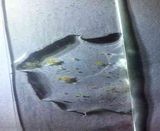 See on the left side? THAT IS A CRAB! There are actually four on the slide but only the one is was crawling around. I would estimate them at about a millimeter I tried to get some photos, but if they aren't moving they just sort of look like debris. Here's one of the better shots I got: 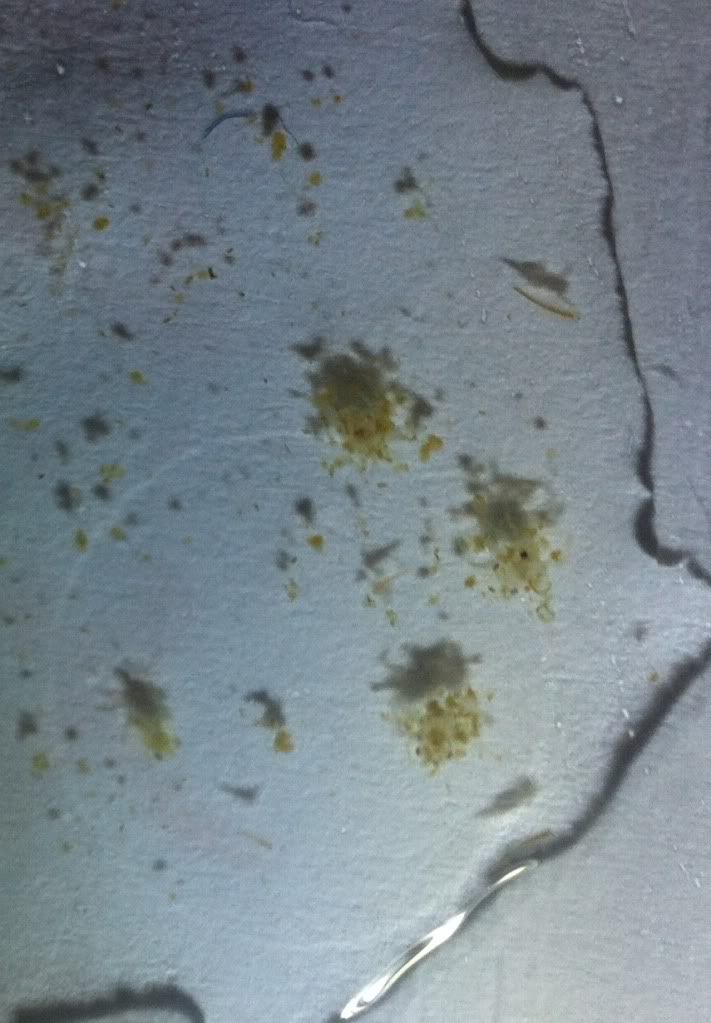
<message edited by shannpeach on Friday, September 27, 2013 8:46 AM>
|
|
|
 Re: Breeding Journal, Species: Mithraculus forceps
Tuesday, September 24, 2013 9:26 AM
Re: Breeding Journal, Species: Mithraculus forceps
Tuesday, September 24, 2013 9:26 AM
( permalink)
Had a small hatch last night on 9-23-2013. I put them in the cone shaped inverted 3L water bottle and have that resting in a water pitcher so it doesn't tip over, and then have that in a BRT (that has the newest peppermint shrimp larvae in it) so this time I can rear them at higher temperatures (above 76F, room temp). I fed them nhbbs this morning and added some nannochloropsis. I am using a rigid airline again that goes all the way to the bottom (the cap since it's inverted) to try to keep them from settling.
|
|
|
 Re: Breeding Journal, Species: Mithraculus forceps
Friday, September 27, 2013 8:45 AM
Re: Breeding Journal, Species: Mithraculus forceps
Friday, September 27, 2013 8:45 AM
( permalink)
Did a 90% water change last night to get most of the artemia out of the tupperware container. When the water level was lower I was able to get a pic (best I could do!) of the little crabs. There are three in this picture; can you see them?  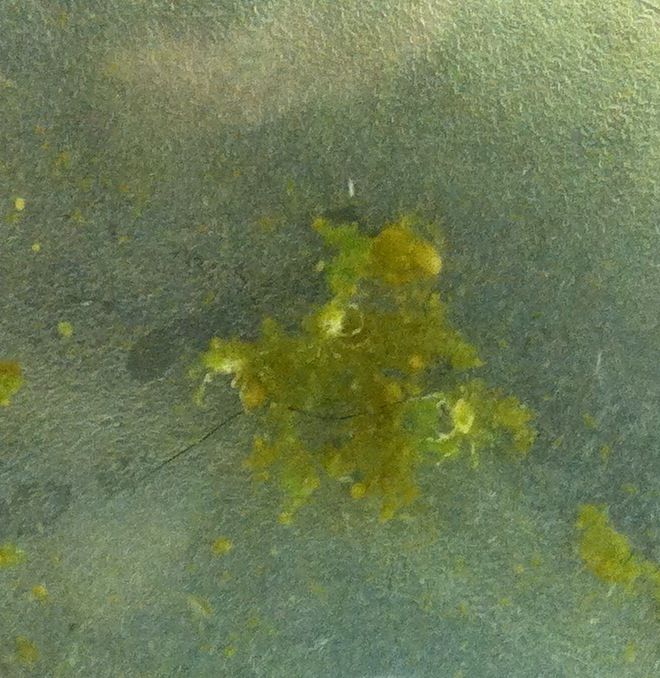 I would say that they are perhaps 2mm across, but I haven't actually measured them yet. They are definitely easier to see now than they were even a couple days ago. I counted 10 or 11 total (still hard sometimes to tell what is a little crab and what is just gunk on the bottom).
|
|
|
 Re: Breeding Journal, Species: Mithraculus forceps
Friday, September 27, 2013 12:09 PM
Re: Breeding Journal, Species: Mithraculus forceps
Friday, September 27, 2013 12:09 PM
( permalink)
Yes, I see them! Very nice.
|
|
|
 Re: Breeding Journal, Species: Mithraculus forceps
Tuesday, October 1, 2013 9:55 AM
Re: Breeding Journal, Species: Mithraculus forceps
Tuesday, October 1, 2013 9:55 AM
( permalink)
So the oldest of these guys (the only ones that are actually crabs) are about a week post settlement and a couple of them are already starting to look sort of reddish. Which makes me think some of them have molted at least once as crabs. 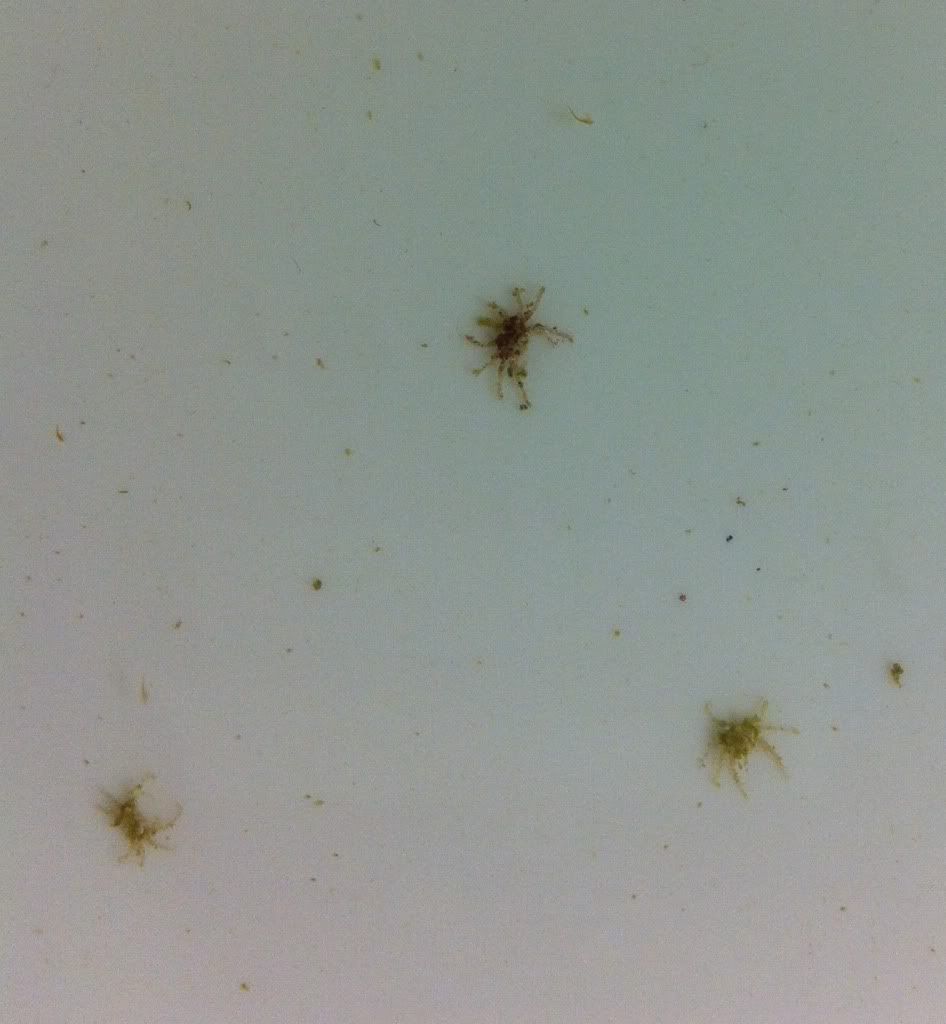 Last night they were moved to a 3 gallon (or so) dishpan which only has about a gallon of water in it currently (it will be brought up a gallon of water at a time over today/tomorrow). I cleaned out the bowl they were in and will use it for the next round of megalopa that should be ready for settlement in a couple days. I will likely move those guys to the bowl tomorrow (or perhaps today...but probably tomorrow)
|
|
|
 Re: Breeding Journal, Species: Mithraculus forceps
Thursday, October 3, 2013 8:36 AM
Re: Breeding Journal, Species: Mithraculus forceps
Thursday, October 3, 2013 8:36 AM
( permalink)
Last night I finally got around to moving the Day 9 megalopae to the "settling bowl" and there were two things of note, one a surprise and the other not too shocking. The not too shocking thing (based on my rather lazy approach this run with these guys) was the large die off. The surprise was that at day 9, most of the remaining alive M. forceps were actually already CRABS, so that was fast! There were a couple megalopae yet also. The crabs went into the dishpan "growout" and the megalopae were put in the settling dish.
Then I peeked at the batch of M. forceps I have at day 4 (yesterday...Today is day 5) and those guys were already mainly megalopae with a few Z2 still cruising around, although there had been large die-off in that container also. I put the Z2 and the Megalopae into the settling dish. This morning they got some Isochrysis and some bbs.
|
|
|
 Re: Breeding Journal, Species: Mithraculus forceps
Monday, October 21, 2013 8:44 AM
Re: Breeding Journal, Species: Mithraculus forceps
Monday, October 21, 2013 8:44 AM
( permalink)
The lack of care these larvae and early juvenile crabs can withstand simply amazes me. I had a container going for about two weeks that I pretty much forgot about and when I checked it this weekend there were about ten crabs. The only thing I did was put in bbs every couple days and maybe a bit of phyto twice. No water changes or anything and it was only a 3L bottle with less than 3L of water in it. Amazing! Anyway, I caught a crab from the oldest batch and snapped a picture this weekend since they are really taking on their red coloring now: 
|
|
|
 Re: Breeding Journal, Species: Mithraculus forceps
Saturday, November 9, 2013 10:46 PM
Re: Breeding Journal, Species: Mithraculus forceps
Saturday, November 9, 2013 10:46 PM
( permalink)
These guys have been in a ~3 gallon dishpan sitting on my kitchen counter with a sponge filter, a strip light over it and no heater for quite some time. They got fed about...once a week. Maybe. To be honest, I sort of haven't done much of anything with or for them. No water changes and only fed some flake or pellet every once in a while. They have endured a lot of neglect from me... Today, I decided I wanted to get the dishpan "growout" off my kitchen counter, so I put them into the S. scovelli growout. I was pleasantly surprised to find I had twenty or so still alive and the largest were approximately 5 mm across (carapace). 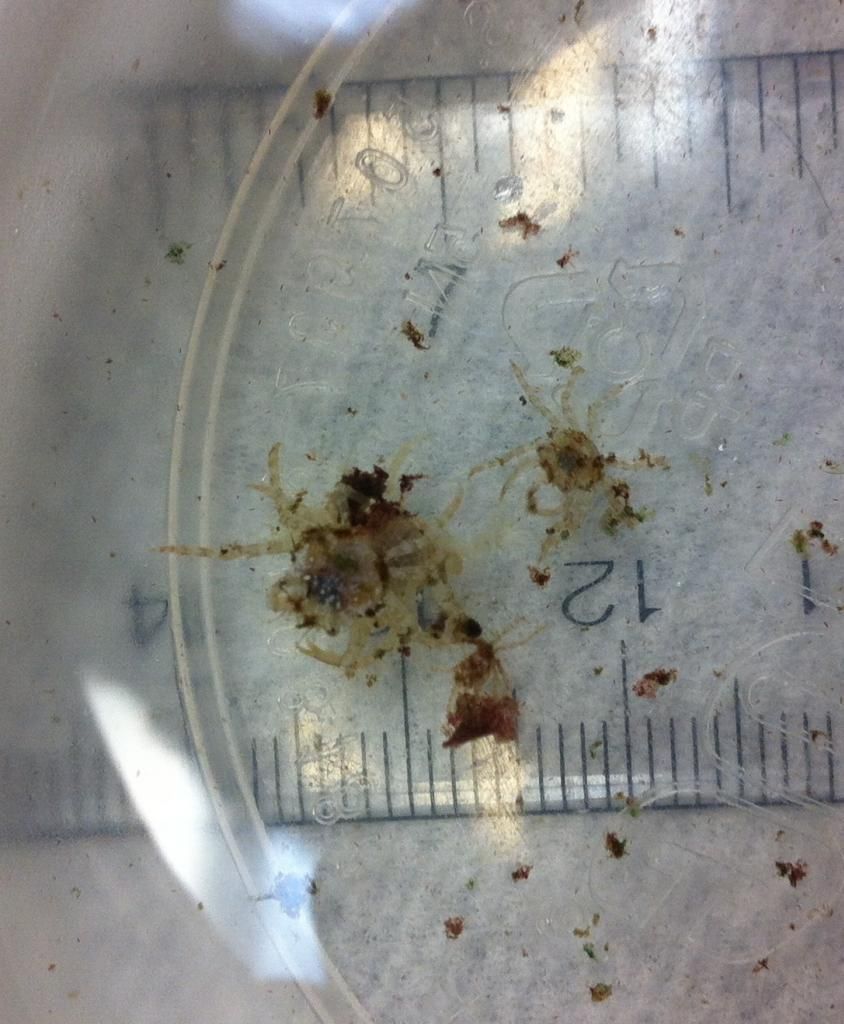 Oddly, they aren't red anymore, but are more of an off white color. Once they were put in the new growout nearly all immediately started chowing on algae growing in there.
|
|
|
 Re: Breeding Journal, Species: Mithraculus forceps
Sunday, November 24, 2013 8:39 PM
Re: Breeding Journal, Species: Mithraculus forceps
Sunday, November 24, 2013 8:39 PM
( permalink)
|
|
|
 Re: Breeding Journal, Species: Mithraculus forceps
Monday, December 9, 2013 9:26 AM
Re: Breeding Journal, Species: Mithraculus forceps
Monday, December 9, 2013 9:26 AM
( permalink)
This weekend I saw one of the adult crabs fanning eggs. Luckily she was in a spot where I could try to take pics, but the area was also a bit dark. So I had to try to hold a flashlight at just the right angle and try to focus my crappy phone camera and then snap a pic. This was the best one I was able to get. I drew an arrow to show where the eggs are. I hope to see her again in that spot so I can try to get more pics, perhaps with a better camera. 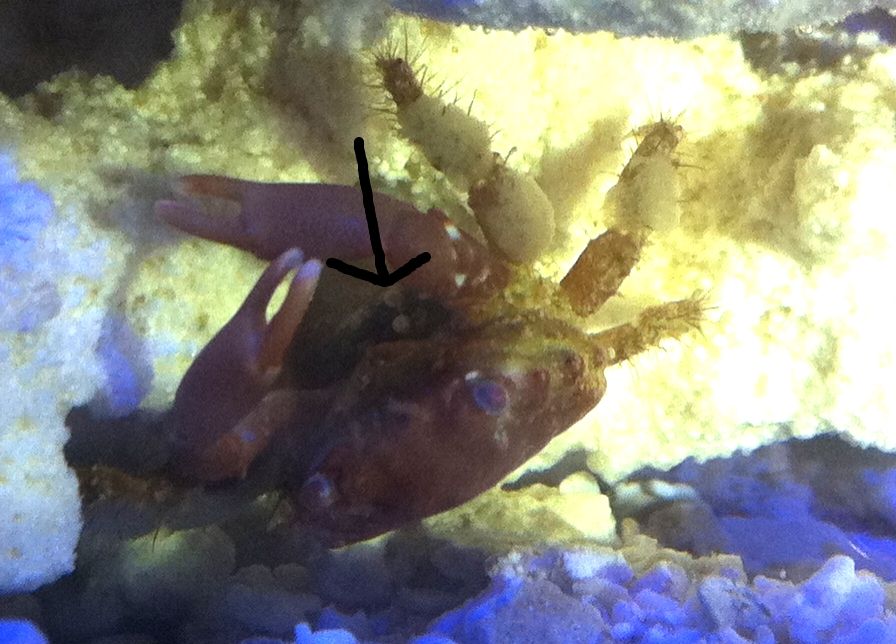 Edit: For whatever reason photobucket is not linking to the modified image where I cropped to just the crab and put the arrow in, it is posting the original image. I have no idea what the deal is with that. I will try to figure it out soon(ish).
|
|
|
|